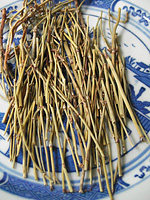|
 |
| Ma Huang |
| |
|
| Name |
Latin Name: Herba Ephedrae
Common Name: Ephedra
Scientific Name: Ephedra sinica Stapf.
Chinese Name: 麻黃
Pinyin Name: ma huang |
| Top |
|
| Origin |
|
The twigs or fine stems of Ephedra sinica Stapf., Ephedra intermedia Schrenk et C. A. Mey., and Ephedra equisetina Bge., plants of the Ephedraceae family. The medicinal part is in raw form, processed with honey, or made into fibers for clinical use. [1], [3] |
| Top |
|
| Where Does It Grow? |
| Ephedra is mainly produced in Xinjiang, Inner Mongolia, Shanxi, Shaanxi and Ningxia provinces. [2] |
| Top |
| Nature and Flavor |
| Ephedra is pungent and slightly bitter in flavors, warm in nature and manifests its therapeutic actions in the lung and bladder meridians. [3] |
| Top |
|
| Identified Active Components/ Major Chemical Constituents |
| Ephedra mainly contains alkaloids such as L-ephedrine and D-pseudoephedrine, and also volatile oils. |
| Top |
|
| Drug actions in TCM |
| Ephedra promotes perspiration, soothes airways and relieve general swelling. [3] |
| Top |
|
| Traditional Uses in TCM |
|
Ephedra is often used to treat respiratory, skin and urinary problems. [3], [4]
 |
Ephedra is an important ingredient for clearing wind and cold in the superficial portion of the body. For exterior syndromes, such as common colds and flu that present with chills, fever, headache and general soreness, ephedra along with cassia twig is often indicated such as the Ephedra Decoction . When individuals have a weakened immune system, it is proper to use with prepared aconite root. |
 |
Ephedra can be used in cough and panting conditions that due to wind and cold disturbing the lungs. It is often combined with bitter apricot kernel and liquorice root, such as the Three Abnormally Combined Decoction. When the cough is productive, Manchurian wildginger, dried ginger and pinellia tuber should be added to clear the excessive phlegm; for those with thick yellow sputum and high fever, gypsum should be added to clear the excessive heat. |
 |
Ephedra promotes perspiration and urination, and thus can be used to relieve fluid retention. For example, nephritis that leads to general swelling, urinary difficulty, aversion to wind blowing, fever and headache, ephedra is prescribed with herbs like largehead atractylodes rhizome and fresh ginger. Moreover, ledebouriella root and notopterygium root will be combined in the acute stage, while aconite root will be combined in persistent cases. |
 |
Ephedra can relieve joint or bone pain. The herb often works with herbs such as notopterygium root, pubescent angelica root, largehead atractylodes rhizome, cassia twig and angelica root to promote blood circulation as well as reduce swelling and inflammation of the regions. |
 |
Ephedra enhances lung functioning and acts on the body surface. It is often used with herbs like ledebouriella root, cicada slough, silkworm and rehmannia root to treat various skin rashes. |
 |
Ephedra can dissolve accumulation and remove stagnation, it can work with herbs like processed rhemannia rhizome, cassia bark, deerhorn glue and white mustard seed to treat chronic pus-forming infections. |
|
| Top |
|
| Pharmacological Actions |
|
|
| Top |
|
| Administration and Dosage |
| For decoction, 3-10g each time, a higher dose is indicated for conditions like general swelling, joint or bone pain. Crude ephedra is used for promote perspiration and urinary; processed ephedra is used for respiratory conditions. [3], [4] |
| Top |
|
| Adverse Effect, Side Effects and Cautions |
| Individuals with general weakness and sweating problems should use with caution. Improper use or overdose can cause headache, palpitation, sweating, hypertension and abnormal heart beating. [3], [4] |
| Top |
|
| References |
| 1. |
李家實主編《中藥鑒定學》上海科學技術出版社, 2000年2月. |
|
|
| 2. |
趙中振主編《香港中藥材圖鑑》香港浸會大學中醫藥學院,2004年6月. |
|
|
| 3. |
雷載權主編《中藥學》上海科學技術出版社, 2000年6月. |
|
|
| 4. |
陶御風編著《臨証本草》人民衛生出版社,2005年5月. |
|
| Top |
|
|
|